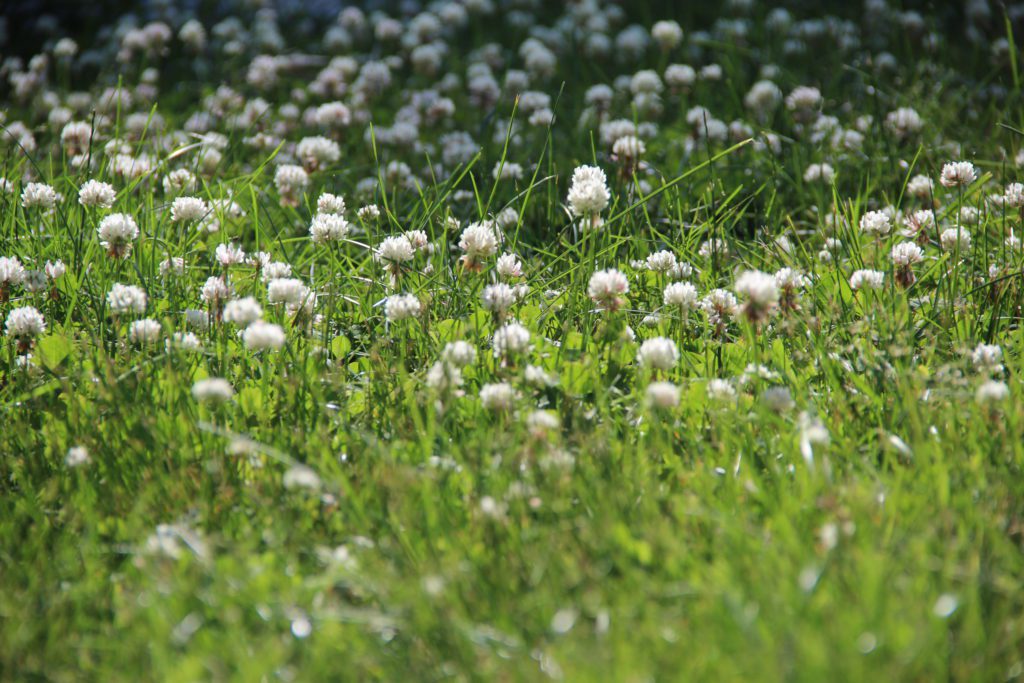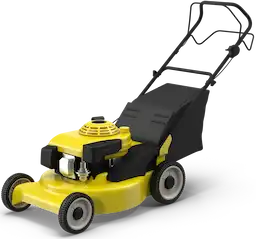Just as Hercules faced the intimidating task of cleaning the Augean stables, managing clover in your lawn can seem overwhelming. Yet, with the right strategies, it becomes a manageable task. Start by recognizing clover’s trifoliate leaves; hand-pulling is effective post-rain. Use a post-emergent herbicide like 2,4-D for targeted removal. Mowing higher at 3 to 4 inches helps suppress regrowth. But why does clover keep returning, and how can you guarantee it doesn’t?
Clover: A Friend or a Foe?
You can spot clover in your lawn by its trifoliate leaves and small, round white or pink flowers, commonly seen in the form of white clover.
Though often labeled a weed due to its ability to spread rapidly, clover enriches soil with nitrogen and supports pollinators.
Its resilience allows it to thrive in under-nourished soils, often outcompeting grass, but with strategic lawn care, you can manage its presence effectively.
Easily hire the best lawn & landscape pros working in your neighborhood.
What Clover Looks Like in Your Lawn

Identifying clover in your lawn is essential for effective management, and recognizing its distinctive features can guide your decision on whether it’s a friend or foe. Clover, with its trifoliate leaves and small clusters of white or pink flowers, stands out. It thrives in nutrient-poor soils. Understanding these traits aids you in deciding whether to accept or remove clover for a healthier lawn.
| Feature | Description | Impact on Lawn |
|---|---|---|
| Leaf Structure | Trifoliate leaves | Competes with grass |
| Flower Appearance | White or pink clusters | Aesthetic consideration |
| Soil Preference | Nutrient-poor environments | Spreads in unfavorable areas |
Is Clover Actually a Weed?
Recognizing clover in your lawn might lead you to question its role: is it a troublesome weed or a beneficial companion?
Clover growing rapidly can compete with grass for essential resources, prompting the need for weed control. However, its ability to fix nitrogen enriches the soil, diminishing the requirement for synthetic fertilizers.
Balancing aesthetics with ecological benefits determines if clover is your friend or foe.
Why Clover Thrives And When It Becomes a Problem
When examining why clover thrives in certain lawns, it’s crucial to take into account the conditions that favor its growth.
To prevent clover in your lawn, address these factors:
- Compacted soil conditions
- Low nitrogen availability
- Presence of bare patches
- Acidic or alkaline soil environments
- Rapid spread through seeds and stolons
Understanding these interactions can help you manage clover effectively, ensuring a healthy, uniform grass lawn.
How to Get Rid of Clover in Lawn Naturally
To tackle clover naturally, start by hand-pulling with precision, ensuring you extract the entire root system to prevent regrowth.
You can also smother clover by applying mulch or covers to block sunlight and suppress its spread while providing soil benefits.
Furthermore, adjusting your soil’s pH to a more alkaline level can discourage clover growth, as it thrives in acidic conditions.
Easily hire the best lawn & landscape pros working in your neighborhood.
Hand-Pulling with Precision
One effective strategy for naturally eliminating clover from your lawn is hand-pulling, which requires a precise technique to guarantee thorough removal.
- Hand-pulling clover is easiest when the soil is moist.
- Grasp stems near the ground and pull upwards with a twisting motion.
- Remove clover before it flowers to prevent seeding.
- Regularly inspect and remove new growth.
- Wear gloves and seal removed clover in bags.
Smothering Clover with Mulch or Covers
Although smothering clover might seem unconventional, it’s a highly effective natural method to control its spread.
By covering clover patches with a 2-3 inch layer of organic mulch, you deprive the plants of essential sunlight and airflow. This method not only kills clover but also retains soil moisture and enhances soil health.
For persistent areas, use landscape fabric as an additional smothering barrier.
Adjusting Soil pH to Discourage Growth
Adjusting your lawn’s soil pH is a strategic step to naturally discourage clover’s growth. Conduct a soil test to identify current pH levels. Aim for a more alkaline environment to inhibit clover seeds.
Consider these actions:
- Add lime to increase soil pH above 7.0.
- Aerate regularly to enhance soil structure.
- Use high-nitrogen fertilizers.
- Address nutrient deficiencies.
- Promote healthy grass growth.
Using Herbicides to Remove Clover Safely
To effectively eliminate clover using herbicides, choose a post-emergent product specifically targeting broadleaf weeds, like 2,4-D or dicamba, ensuring it’s compatible with your grass type.
Timing is essential; apply the herbicide when clover is actively growing, ideally in late spring or early summer, and consider evening applications to enhance absorption.
Prioritize environmental safety by following the manufacturer’s guidelines on application rates and safety precautions, and employ spot spraying techniques to minimize unintended damage to your lawn.
Post-Emergent Herbicides that Target Broadleaf Weeds
Effectively removing clover from your lawn often involves utilizing post-emergent herbicides specifically targeted at broadleaf weeds.
To control clover, consider:
- Applying selective post-emergent herbicides like Triclopyr, 2,4-D, or MCPP.
- Targeting applications during active growth in late spring or early summer.
- Spraying in the evening post-mowing for better penetration.
- Performing follow-up spot treatments for resilient patches.
- Adhering to manufacturer guidelines for safe, effective use.
Timing Applications for Maximum Effectiveness
When aiming for maximum effectiveness in using herbicides to remove clover, timing is essential. Apply herbicides in late spring or early summer when clover actively grows. Mow two days prior to application to boost penetration. Evening applications improve absorption. Avoid temperatures above 90°F to uphold effectiveness. Consider follow-up treatments for complete eradication.
| Timing Applications | Herbicide Tips |
|---|---|
| Late Spring/Summer | Apply when clover is active |
| Two Days After Mowing | Boosts product penetration |
| Evening | Increases absorption |
| Below 90°F | Upholds herbicide efficacy |
| Follow-Up Treatments | Guarantees complete eradication |
Environmental Safety and Application Tips
Although managing clover in your lawn can be challenging, using herbicides safely and effectively requires a thoughtful approach to environmental considerations.
Select a weed killer that targets broadleaf weeds without harming your grass. Verify correct application rates by following manufacturer’s guidelines.
Consider these tips:
- Apply in late spring or early summer.
- Opt for evening applications.
- Mow two days before and after.
- Match herbicide to turf type.
- Use protective gear.
Why Clover Keeps Coming Back and How to Stop It
To prevent clover from returning, make certain you mow your lawn at the correct height, as cutting grass too short weakens it and encourages clover proliferation.
Regularly aerate and overseed your lawn to improve grass density, which creates a competitive environment that inhibits clover growth.
Furthermore, manage nitrogen levels by using a balanced fertilization schedule, as healthy soil enriches grass and diminishes conditions that favor clover.
Mowing, Watering, and Fertilizing the Right Way
If you’re struggling with clover consistently returning to your lawn, optimizing your mowing, watering, and fertilizing practices is essential to curbing its growth.
Mow at a height of 3 to 4 inches to shade clover. Water deeply and infrequently to strengthen grass roots. Apply balanced fertilizers regularly. Maintain soil pH. Enhance soil health.
- Mow at 3 to 4 inches
- Water deeply, infrequently
- Fertilize regularly
- Maintain soil pH
- Improve soil health
Aeration and Overseeding to Strengthen Grass Density
Building on the foundation of proper mowing and watering, it is crucial to focus on aeration and overseeding to enhance your lawn’s density and resilience against clover. Aeration improves soil structure, allowing air, water, and nutrients to penetrate deeply, while overseeding introduces new grass varieties, boosting thickness.
| Benefit | Description |
|---|---|
| Aeration | Enhances root strength by improving soil aeration. |
| Overseeding | Fills bare spots, increasing grass density. |
| Thicker Lawn | Outcompetes clover, limiting its sunlight access. |
Managing Nitrogen and Soil Health Over Time
Although clover often signals a deficiency in lawn care, managing nitrogen and soil health can effectively curb its recurrence.
Ascertain your lawn thrives by focusing on these strategies:
- Apply nitrogen-rich fertilizers quarterly.
- Aerate soil regularly to prevent compaction.
- Conduct soil tests to maintain balanced pH.
- Practice deep watering to encourage robust grass roots.
- Mow at a height of 3 inches or higher.
Easily hire the best lawn & landscape pros working in your neighborhood.
Special Tips for Dealing with White Clover
To effectively manage white clover, it’s vital to understand its behavior as a nitrogen-fixing plant that thrives in nutrient-poor soils, making a well-fed lawn essential.
For precise removal, target white clover before it flowers, using manual extraction to guarantee complete root removal and applying herbicides like 2,4-D or triclopyr in late spring.
Maintain grass height at 3 inches or more to shade the soil and suppress clover regrowth, ensuring your lawn remains dense and competitive.
How White Clover Behaves Differently
When tackling white clover in your lawn, understanding its unique behaviors is essential for effective management.
To remove clover, consider these strategies:
- Spreads through stolons, forming dense mats; manage by disrupting these structures.
- Thrives in under-nourished lawns; guarantee proper fertilization.
- Fixes nitrogen, flourishing in compacted soils; prioritize aeration.
- Shade with mowing at 3 inches or more.
- Use targeted herbicides during active growth.
Targeted Removal Tactics for White Clover in Lawn
Managing white clover in your lawn requires specialized strategies tailored to its unique characteristics.
Use targeted herbicides like triclopyr during late spring to control clover effectively while sparing your grass. For smaller patches, manual removal is key, pull clover by the roots when the soil is moist to prevent regrowth.
Adjust mowing height to 3-4 inches and fertilize with nitrogen to promote grass dominance.
Need Help Getting Rid of Clover in Your Lawn? LawnGuru Can Help
Struggling to banish clover from your lawn?
LawnGuru’s professional lawn care services can help you effectively remove clover infestations. We tailor our approach using selective herbicides and manual techniques.
Our expert team will:
- Assess lawn health for nutrient deficiencies
- Schedule ideal treatment times
- Promote thicker grass growth
- Utilize manual removal and selective herbicides
- Save you time while maintaining lawn health





